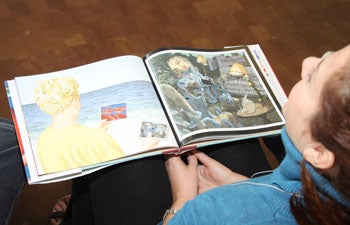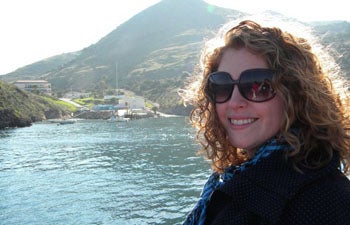A Flotsam of Innovation
A scientific diver, USC Dornsife’s Johanna Holm, has become a “transmedia storyteller.”
The Ph.D. candidate in marine environmental biology is helping transform the award-winning children’s book Flotsam into a multifaceted digital application.
Conceived and illustrated by David Wiesner, the picture book Flotsam centers on the exploits of a boy on the beach who discovers a camera that has drifted through the ocean, taking photos of plants and animals underwater and of children on shore who have picked up the camera and then tossed it back.
Holm describes the Flotsam project as something akin to a comic strip, one displayed on the screen of an iPad instead of printed on newsprint and illustrated with images that are animated instead of static. For example, when the boy in the story discovers the camera on the beach, the camera is encrusted with barnacles. Clicking on the barnacles on the screen will display text and provide an audio pronunciation of the word. Holm is the voice of the pronunciations and all the other spoken material in the project.

Johanna Holm (pictured here underwater) took her book project collaborators to USC Dornsife’s Wrigley Marine Science Center on Catalina Island to introduce them to life in Big Fisherman’s Cove. Photo by Karla Heidelberg.
The “dynamic book” features marine plants and animals, but Holm is the only one in the research group who has firsthand experience with them. Using Wiesner’s work — his illustrations earned him the 2007 Caldecott Medal — the project also involves students and staff at USC Annenberg School for Communication and Journalism, USC School of Cinematic Arts, USC Viterbi School of Engineering and a “think-and-do tank” called The Alchemists Transmedia Storytelling Company.
To get her collaborators better acquainted with ocean life, she took them to the Wrigley Marine Science Center on Catalina Island and they all went snorkeling in Big Fisherman’s Cove.
“We got them into the water so they could finally see what I meant when I said ‘kelp,’ ” Holm said. “Some of them had never seen it before. Some had never snorkeled before.”
Holm came to USC Dornsife in 2010 as a graduate student of Karla Heidelberg, assistant professor of biological sciences in USC Dornsife. Holm is studying microbial diversity associated with gorgonian corals in Southern California; she passed her qualifying exams for her Ph.D. in January. She has been involved in some form of marine research for more than a decade, and balances her scientific work with educational outreach.
As an undergraduate student at Millersville University in Pennsylvania, she gave tours of the cephalopod laboratory where she worked to school groups. After earning her bachelor’s degree, she worked at The Marine Science Consortium at Wallops Island, Va., as a “K through Gray” educator.

The book project is based on Flotsam. Conceived and illustrated by David Wiesner, the picture book centers on the exploits of a boy on the beach who discovers a camera that has drifted through the ocean, taking photos of plants and animals underwater along the way. Photo courtesy of the USC Annenberg Innovation Lab.
As a graduate student in USC Dornsife, she has volunteered as a mentor to the QuikSCience Challenge science competition and as an adviser for the Summer Undergraduate Research Experience at the Wrigley Marine Science Center. Her participation in the “transmedia” project is a natural choice for her, although it has proven to be as unfamiliar to her as marine science is to her collaborators at USC Annenberg School for Communication and Journalism.
“I’ve been working with them for more than a year, and I spent the first three or four months just trying to understand what they were talking about,” she said. “They’re communications people and I’m the only scientist in the room.”
Managed by the Annenberg Innovation Lab, the dynamic book teaches the 21st century second-grade audience the concept of film. The story plot in Flotsam deepens when the boy discovers that the camera is a film camera. Prompts within the storyline explain the idea of “film” and the protagonist searches for a business that can process this mysterious media. The resulting photos are displayed in the dynamic book as fantastic and animated images of fish and octopuses. The dynamic book also introduces the viewers to the use of microscopes and to concepts of magnification that allow the display of “pictures within the pictures.”

Johanna Holm at the Wrigley Marine Science Center on Catalina Island. Photo by Karla Heidelberg.
The technical portions of the project have been completed, and now the group is working on education curricula to make it useful in a grade school classroom. When it’s finished, it will be available as an app through the Apple Store.
Holm’s work with staff and students at USC Annenberg has taught her some of the jargon of 21st century digital communication. It’s also given her the chance to apply and refine her own skills as a science educator.
“One of my biggest strengths is communicating science to non-scientists,” she said. “This has been a golden opportunity for me working with these collaborators. In every meeting we have, I try to explain some of the scientific language to them. They really get a kick out of the word ‘dinoflagellate.’ ”